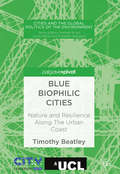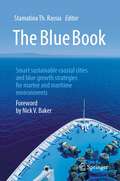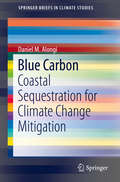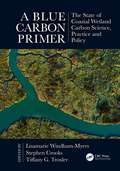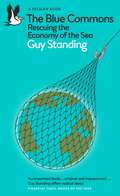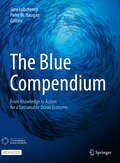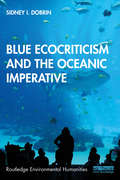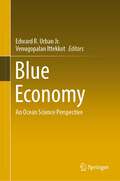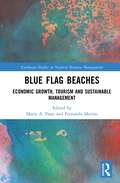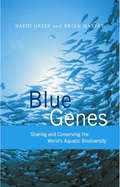- Table View
- List View
Blue Biophilic Cities: Nature and Resilience Along The Urban Coast
by Timothy BeatleyThere is a growing recognition of the contact we need with nature to be happy, healthy and to lead meaningful lives. We need that nature daily, if not hourly, and so it must be nearby to where we live and work. This is central to the concept of ‘biophilic cities’ which is emerging as a global movement and guiding framework for city design and planning. Blue Biophilic Cities is about the promise of this movement and a kind of biophilic urbanism that is possible for cities perched on the edge of harbours and seas. In blue biophilic cities, much of the nearby nature is to be found in the marine realm. This book explores the efforts underway in a number of cities to foster new marine connections through a variety of innovative programs and initiatives. It also discusses a number of design ideas, from dynamic shoreline edges and floodable parks to living breakwaters, in order to emphasise the possibility of designing for resilience while also supporting marine biodiversity and strengthening biophilic connections to the marine world.
The Blue Book: Smart sustainable coastal cities and blue growth strategies for marine and maritime environments
by Stamatina Th. RassiaThis volume offers a wealth of results written by experts from interdisciplinary fields, contributing on a diversity of topics targeting marine and maritime environmental sustainability in coastal and ocean-related areas. The reader will benefit from the diversity and breadth of topical coverage as well as concepts conveyed from a variety researchers. The book serves as an open knowledge platform combining many aspects of SDG #11 including naval architecture and marine engineering, ecology, biomedical informatics, public health, architecture engineering and building physics, nanotechnology as well as advanced technologies, innovation and related fields. The broad range of topics cover ecology, shipping, and health related issues. Specifically, the book presents chapters on the following: · Shipping and ecology · Topics of ocean wildlife and mega-fauna protection · Big Data and sustainable applications for healthy and safe coastal cities · Smart sustainable humanitarian assistance methods using large vessels · Smart coastal city tourist activity, mobility management · Urban climate condition mitigation · Historical analysis of the case of disease outbreaks onboard ships · Monitoring, simulating and decision making while developing housing at sea, such as in cruise-ships · Conducting feasibility assessment for outbreak prevention following real-time, systematic disease detection on cruise ships · Technological approaches for cruise ship disease propagation monitoring · Scenario testing for sensors and actuators deployment to prevent and mitigate epidemics on cruise ships, as well as methods for improving biological safety on ships using nanotechnology The book is expected to engage researchers in multidisciplinary areas as well as students and interested readers.
Blue Carbon: Coastal Sequestration for Climate Change Mitigation (SpringerBriefs in Climate Studies)
by Daniel M. AlongiThis work summarizes the science and management of a rapidly expanding topic in climate science, namely adaptation and mitigation. The term 'blue carbon' refers to the rates, pathways and volumes of greenhouse carbon sequestered in coastal estuarine and marine ecosystems such as salt marshes, mangroves and seagrass meadows. Blue carbon and its vital role in climate change mitigation are central to this book.Readers find summaries and analysis of both the basic scientific data and data from blue carbon field projects, and a practical guide on how to manage a successful blue carbon field project. There is a discussion on how to maximize the carbon sequestration and consideration of whether blue carbon projects make a difference.The work is not only of interest to scholars involved in climate science, but also those in the marine sciences, and those in ecosystem ecology, biogeochemistry; geochemistry; estuarine and marine plant ecology.
Blue Carbon Dynamics of the Indian Ocean: The Present State of the Art
by Abhra Chanda Sourav Das Tuhin GhoshThis book gives an overview of various aspects of blue carbon dynamics from each country bordering the Indian Ocean. Given the importance of the topic of blue carbon, it can be assumed that in near future, more and more researchers from the Indian Ocean countries will pursue environmental research in this domain. This book is a ready reference to all those who are interested to have a holistic understanding about the ground scenario of blue carbon in the Indian Ocean. There are many research institutes situated in the periphery of the Indian Ocean that are devoted to nurturing the new avenues of marine carbon research. Researchers and scholars interested in this domain will find this book provides a good overview, wherein all the necessary information on the status and functioning of these blue carbon ecosystems are detailed in a concise way. The book is also helpful to postgraduate students of ‘marine science’ or those who have a specialization in ‘marine biogeochemistry’ or ‘chemical oceanography’ to develop a basic understanding about the very concept of ‘blue carbon’ from the perspective of the Indian Ocean.
Blue Carbon in Shallow Coastal Ecosystems: Carbon Dynamics, Policy, and Implementation
by Tomohiro Kuwae Masakazu HoriThis book presents a comprehensive and innovative understanding of the role of shallow coastal ecosystems in carbon cycling, particularly marine carbon sequestration. Incorporating a series of forward-looking chapters, the book combines thorough reviews of the global literature and regional assessments—mainly around the Indo-Pacific region and Japan—with global perspectives to provide a thorough assessment of carbon cycling in shallow coastal systems. It advocates the expansion of blue-carbon ecosystems (mangroves, seagrass meadows, and salt marshes) into macroalgal beds, tidal flats, coral reefs, and urbanized shallow waters, demonstrating the potential of these ecosystems as new carbon sinks. Moreover, it discusses not only topics that are currently the focus of blue-carbon studies, i.e., sedimentary carbon stock and accumulation rate, but also CO2 gas exchange between the atmosphere and shallow coastal ecosystems, carbon storage in the water column as refractory organic carbon, and off-site carbon storage. Including highly original contributions, this comprehensive work inspires research beyond the specific regions covered by the chapters. The suite of new concepts and approaches is refreshing and demonstrates that blue-carbon research is indeed a vibrant new field of research, providing deep insights into neglected aspects of carbon cycling in the marine environment. At the same time the book provides guidance for policy makers to deliver benefits to society, for example the inclusion of blue carbon as a carbon offset scheme or the Nationally Determined Contribution (NDC) in the Paris Agreement, and also for building resilience in coastal socio-ecosystems through better management. This book is intended for all those interested in the science and management of coastal ecosystems.
A Blue Carbon Primer: The State of Coastal Wetland Carbon Science, Practice and Policy (CRC Marine Science)
by Lisamarie Windham-Myers Stephen Crooks Tiffany G. TroxlerKey features: Captures the historic context and recent developments in science and policy arenas that address the potential for coastal wetlands to be considered as significant contributors to carbon sequestration Links multiple levels of science (biogeochemistry, geomorphology, paleoclimate, etc.) with blue carbon concepts (science, policy, mapping, operationalization, economics) in a single compendium Concludes with a discussion of future directions which covers integrated scientific approaches, impending threats and specific gaps in current knowledge Includes 7 case studies from across the globe that demonstrate the benefits and challenges of blue carbon accounting Written by over 100 leading global blue carbon experts in science and policy. Blue Carbon has emerged as a term that represents the distinctive carbon stocks and fluxes into or out of coastal wetlands such as marshes, mangroves, and seagrasses. The Blue Carbon concept has rapidly developed in science literature and is highly relevant politically, as nations and markets are developing blue carbon monitoring and management tools and policies. This book is a comprehensive and current compendium of the state of the science, the state of maps and mapping protocols, and the state of policy incentives (including economic valuation of blue carbon), with additional sections on operationalizing blue carbon projects and 7 case studies with global relevance.
A Blue Carbon Primer: The State of Coastal Wetland Carbon Science, Practice and Policy (CRC Marine Science)
by Lisamarie Windham-Myers Stephen Crooks Tiffany G. TroxlerKey features: Captures the historic context and recent developments in science and policy arenas that address the potential for coastal wetlands to be considered as significant contributors to carbon sequestration Links multiple levels of science (biogeochemistry, geomorphology, paleoclimate, etc.) with blue carbon concepts (science, policy, mapping, operationalization, economics) in a single compendium Concludes with a discussion of future directions which covers integrated scientific approaches, impending threats and specific gaps in current knowledge Includes 7 case studies from across the globe that demonstrate the benefits and challenges of blue carbon accounting Written by over 100 leading global blue carbon experts in science and policy. Blue Carbon has emerged as a term that represents the distinctive carbon stocks and fluxes into or out of coastal wetlands such as marshes, mangroves, and seagrasses. The Blue Carbon concept has rapidly developed in science literature and is highly relevant politically, as nations and markets are developing blue carbon monitoring and management tools and policies. This book is a comprehensive and current compendium of the state of the science, the state of maps and mapping protocols, and the state of policy incentives (including economic valuation of blue carbon), with additional sections on operationalizing blue carbon projects and 7 case studies with global relevance.
Blue Carbon Reservoir of the Blue Planet
by Abhijit Mitra Sufia ZamanThe ever increasing emission of carbon dioxide due to rapid industrialization, urbanization, unplanned tourism and alteration of land use pattern is causing unprecedented changes to marine biodiversity. Irrespective of political philosophy, nation, caste, sex and religion, mankind is under the appalling shadow of climate change. Today nature-based approaches for the mitigation of climate change are increasingly accepted as part of the low-cost solution. Thrust has been given by several scientific communities to assess the magnitude and viability of carbon sequestering potential of plants. Coastal producer communities like mangroves, salt marsh grass, seagrass beds, and seaweeds absorb atmospheric carbon dioxide during the process of photosynthesis. This carbon known as the ‘blue carbon’ is thus associated with the marine and estuarine ecosystems. However, a number of gaps in our scientific knowledge on blue carbon domain still exist. Molluscs, coral reefs, phytoplankton, which are amongst the important storehouses of carbon, have not been addressed. Very few scientific studies on the carbon stored in these valuable natural vaults have been performed, and no data bank is available on their carbon sequestering capacity on global basis. The methodologies for assessing blue carbon stock also need further standardization so that credit from blue carbon reservoir is accepted by the International bodies in the form of a concrete policy. It is a matter of great appreciation that Conservation International (CI), the International Union for Conservation of Natural Resources (IUCN), and the Intergovernmental Oceanic Commission (IOC) of UNESCO is collaborating with governments, research institutions, non-governmental and international organizations, and communities around the world to develop management approaches, financial incentives and policy mechanisms for ensuring conservation and restoration of blue carbon ecosystems and implement projects around the world that demonstrate the feasibility of blue carbon accounting, management, and incentive agreements. The present book has critically presented the data bank for each community of blue carbon not merely in the form of text description, but also through case studies that are the outcomes of research projects and pilot programmes.
The Blue Commons: Rescuing the Economy of the Sea (Pelican Books)
by Guy Standing'A landmark book... The Blue Commons is at once a brilliant synthesis, a searing analysis, and an inspiring call to action.' - David Bollier'With remarkable erudition, passion and lyricism, Guy Standing commands the reader to wake up to the threat posed by rentier capitalism's violent policies for extraction, exploitation and depletion of that which is both common to us all, but also vital to our survival: the sea and all within it.' - Ann Pettifor 'Shines a bright light on the economy of the oceans, directing us brilliantly towards where a sustainable future lies.' - Danny Dorling'This is a powerful, visionary book - essential reading for all who yearn for a better world.' - Jason HickelThe sea provides more than half the oxygen we breathe, food for billions of people and livelihoods for hundreds of millions. But giant corporations are plundering the world's oceans, aided by global finance and complicit states, following the neoliberal maxim of Blue Growth. The situation is dire: rampant exploitation and corruption now drive all aspects of the ocean economy, destroying communities, intensifying inequalities, and driving fish populations and other ocean life towards extinction.The Blue Commons is an urgent call for change, from a campaigning economist responsible for some of the most innovative solutions to inequality of recent times. From large nations bullying smaller nations into giving up eco-friendly fishing policies to the profiteering by the Crown Estate in commandeering much of the British seabed, the scale of the global problem is synthesised here for the first time, as well as a toolkit for all of us to rise up and tackle it.The oceans have been left out of calls for a Green New Deal but must be at the centre of the fight against climate change. How do we do it? By building a Blue Commons alternative: a transformative worldview and new set of proposals that prioritise the historic rights of local communities, the wellbeing of all people and, with it, the health of our oceans.
The Blue Compendium: From Knowledge to Action for a Sustainable Ocean Economy
Home to over 80 percent of all life on Earth, the ocean is the world’s largest carbon sink and a key source of food and economic security for billions of people. The relevance of the ocean for humanity's future is undisputed. However, the ocean’s great potential to drive economic growth and equitable job creation, sustain healthy ecosystems, and mitigate climate change is not yet fully recognised. Lack of awareness of this potential as well as management and governance challenges pose impediments. Until these impediments are removed, ocean ecosystems will continue to be degraded and opportunities for people lost. A transition and a clear path to a thriving and vibrant relationship between humans and the ocean are urgently needed. This open access collection of papers and reports identifies a path that is inspired by science, energised by engaged people, and emboldened by visionary leaders. These assessments of knowledge are commissioned by the High Level Panel for a Sustainable Ocean Economy (Ocean Panel), which was established in September 2018 as a unique initiative led by heads of state and government from around the world, to showcase the latest leading-edge science, knowledge and state-of-the-art thinking on key ocean issues. Altogether, The Blue Compendium offers innovative ocean solutions in technology, policy, governance, and finance realms, that could help accelerate a transition to a more sustainable and prosperous relationship with the ocean. The comprehensive assessments have already informed policy making at the highest levels of government and motivated an impressive array of responsive and ambitious action across a growing network of leaders in business, finance and civil society.
Blue Ecocriticism and the Oceanic Imperative (Routledge Environmental Humanities)
by Sidney I. DobrinThis book initiates a conversation about blue ecocriticism: critical, ethical, cultural, and political positions that emerge from oceanic or aquatic frames of mind rather than traditional land-based approaches. Ecocriticism has rapidly become not only a disciplinary legitimate critical form but also one of the most dynamic, active criticisms to emerge in recent times. However, even in its institutional success, ecocriticism has exemplified an "ocean deficit." That is, ecocriticism has thus far primarily been a land-based criticism stranded on a liquid planet. Blue Ecocriticism and the Oceanic Imperative contributes to efforts to overcome ecocriticism’s "ocean-deficit." The chapters explore a vast archive of oceanic literature, visual art, television and film, games, theory, and criticism. By examining the relationships between these representations of ocean and cultural imaginaries, Blue Ecocriticism works to unmoor ecocriticism from its land-based anchors. This book aims to simultaneously advance blue ecocriticism as an intellectual pursuit within the environmental humanities and to advocate for ocean conservation as derivative of that pursuit.
Blue Ecocriticism and the Oceanic Imperative (Routledge Environmental Humanities)
by Sidney I. DobrinThis book initiates a conversation about blue ecocriticism: critical, ethical, cultural, and political positions that emerge from oceanic or aquatic frames of mind rather than traditional land-based approaches. Ecocriticism has rapidly become not only a disciplinary legitimate critical form but also one of the most dynamic, active criticisms to emerge in recent times. However, even in its institutional success, ecocriticism has exemplified an "ocean deficit." That is, ecocriticism has thus far primarily been a land-based criticism stranded on a liquid planet. Blue Ecocriticism and the Oceanic Imperative contributes to efforts to overcome ecocriticism’s "ocean-deficit." The chapters explore a vast archive of oceanic literature, visual art, television and film, games, theory, and criticism. By examining the relationships between these representations of ocean and cultural imaginaries, Blue Ecocriticism works to unmoor ecocriticism from its land-based anchors. This book aims to simultaneously advance blue ecocriticism as an intellectual pursuit within the environmental humanities and to advocate for ocean conservation as derivative of that pursuit.
The Blue Economy: An Asian Perspective
by Somnath Hazra Anindya BhuktaThis volume defines and analyzes the Blue Economy, a system that encompasses all the economic activities which are happening in and around the ocean within a sustainable development framework, with focus on countries in Asia. This work is timely, as Blue Economy activities account for a significant share of GDPs in the island and coastal economies in the Asia region, sustaining the livelihoods of one of the largest sections of the world's population. This book, therefore, assesses how the Blue Economy contributes to these livelihoods from economic and ecological perspectives and analyzes the various types of ecosystem services provided, and how these services are regulated and maintained. While most studies of the Blue Economy focus only on the economic aspects, this book provides ample statistical data to demonstrate why ecosystem services should additionally be considered for the estimation and valuation of the Blue economy. The book is primarily meant for researchers, students, and teachers in the fields of environmental and ocean economics, sustainable development, and ecosystem services, and will be of further interest to policymakers and government officials working in matters related to the Blue Economy and sustainability policy.
Blue Economy: People and Regions in Transitions (The Dynamics of Economic Space)
by C. Patrick Heidkamp John Edward Morrissey Celine Germond DuretThis book presents state-of-the-art perspectives on the Blue Economy. It applies important geographical and sustainability transitions perspectives and underscores how Blue Economy dynamics are situated in regional contexts and shaped by the people who live there. The book highlights the Blue Economy concept as a potential driver of regionally sensitive, ecologically embedded, and community-focused sustainability. The scope for Blue Economy to form a core "cog" in our low-carbon future is obvious, from the potential for renewable energy production and coastal resilience building to possibilities for sustainable food production and the delivery of economic opportunities for peripheral communities. However, fundamental questions remain on how to meaningfully deliver these promises, such as how to avoid embedding a model of damaging extractivism, as per the terrestrial economy, and how to deliver on the key social sustainability principles of human well-being, equity, and justice when planning and developing blue economies. As the UN Decade of Ocean Science for Sustainable Development opens, this book provides a timely reminder of the richness, diversity, and potential of coastal and marine spaces. It advances geographical and transdisciplinary understandings of the Blue Economy and sets a baseline for continued scholarly engagement with the Blue Economy from a variety of perspectives. This timely contribution will be of interest to policy makers, academics, industry leaders, decision makers, and stakeholders working in or connected to the Blue Economy Sphere and working in the fields of Economic Geography, Regional Development, Public Policy and Planning, Environmental Studies, and Coastal Zone Management.
Blue Economy: People and Regions in Transitions (The Dynamics of Economic Space)
by C. Patrick Heidkamp John Edward Morrissey Celine Germond-DuretThis book presents state-of-the-art perspectives on the Blue Economy. It applies important geographical and sustainability transitions perspectives and underscores how Blue Economy dynamics are situated in regional contexts and shaped by the people who live there. The book highlights the Blue Economy concept as a potential driver of regionally sensitive, ecologically embedded, and community-focused sustainability. The scope for Blue Economy to form a core "cog" in our low-carbon future is obvious, from the potential for renewable energy production and coastal resilience building to possibilities for sustainable food production and the delivery of economic opportunities for peripheral communities. However, fundamental questions remain on how to meaningfully deliver these promises, such as how to avoid embedding a model of damaging extractivism, as per the terrestrial economy, and how to deliver on the key social sustainability principles of human well-being, equity, and justice when planning and developing blue economies. As the UN Decade of Ocean Science for Sustainable Development opens, this book provides a timely reminder of the richness, diversity, and potential of coastal and marine spaces. It advances geographical and transdisciplinary understandings of the Blue Economy and sets a baseline for continued scholarly engagement with the Blue Economy from a variety of perspectives. This timely contribution will be of interest to policy makers, academics, industry leaders, decision makers, and stakeholders working in or connected to the Blue Economy Sphere and working in the fields of Economic Geography, Regional Development, Public Policy and Planning, Environmental Studies, and Coastal Zone Management.
Blue Economy: An Ocean Science Perspective
by Edward R. Urban Jr. Venugopalan IttekkotThe ocean is a major source of income for many coastal nations, particularly in the developing world. Economic benefits from the ocean in the long-term depend on its wise science and technology-based management. The intersection of science, technology, and economy are most obvious in nations' coastal zones. This book highlights the need for the application of ocean science and technology for best economic outcomes. It gives examples of ocean resources and the threats to them from climate change and other human interventions, as well as provides information on the available ocean research and observation tools to monitor their impact as well as on the related internationally available opportunities for capacity development.
Blue Economy in Indian Sundarbans: Exploring Livelihood Opportunities
by Abhijit Mitra Sufia Zaman Prosenjit PramanickThis book provides a cross-sectoral, multidisciplinary assessment of the major verticals of Blue Economy relevant to the mangrove ecosystem in Indian Sundarbans, which is a deltaic complex at the apex of Bay of Bengal. This book evaluates the feasibility of Blue Economy considering the natural resource base in this mangrove dominated deltaic complex.Chapter 1 discusses the need of expanding different marine and estuarine oriented verticals of Blue Economy as the land resources are gradually becoming depleted. Chapter 2 highlights the wide spectrum of biotic and abiotic resources of the Indian Sundarbans which can serve as the strong foundation of expanding Blue Economy in the region. Chapter 3 highlights several mangrove based livelihoods that are not only innovative, but may present new opportunities to initiate cottage industries. Chapter 4 highlights the threats associated with Blue Economy in Indian Sundarbans like, sea level rise, acidification of water, weather extremes, pollution, over-exploitation of natural resources, etc., along with ground-zero environmental data collated over three decades. Chapter 5 offers several solutions to combat the threats to regional Blue Economy emphasizing both technology and policy based management. The book attempts to align the proliferation of different sectors of Blue Economy in the framework of Indian Sundarbans.
Blue Economy of the Indian Ocean: Resource Economics, Strategic Vision, and Ethical Governance
by Ranadhir Mukhopadhyay Victor J. Loveson Sridhar D. Iyer P.K. SudarsanThe economic paradigms currently dominating the world are not sustainable. The threats from climate change, exploitation-based approaches to commerce, and the excess acquisition of resources loom large as well as the possibility of military flare-ups. Maintaining a balance between development and ecosystems, aspirations for growth, and the need for sustainability is a prescient challenge. The Indian Ocean Region (IOR) encompasses some of the poorest countries in the world and those that will bear the brunt of the negative impacts from climate change. This book explores the immense potential of the IOR and how best to maintain sustainable and responsible economic and strategic activities. The combination of science, innovation, and entrepreneurship will create a new blue economy business model, which has the potential to transform society. Based on critical analysis of the model and its practical applications, including risks as well as opportunities, the topics discussed range from food security, energy, and resilience to climate change, trade and investments, and improved maritime connectivity to tourism, poverty alleviation, and socioeconomic growth, encompassing a wide range of interests and expertise. FEATURES Examines the geo-politics, geo-resources, and geo-hazards of the IOR and identifies opportunities and methods to achieve success Covers a detailed assessment of available resources (fisheries, minerals, energy), threats such as pollution (plastic, acoustic, carbon, bio-invasion), geo-politics (maritime security, military invasion), and strategic vision (determining carrying capacity, ethical governance, and responsible ecosystem) of the Indian Ocean Analyzes the economics of the blue economy, the global scenario including the Pacific and Caribbean islands, and the aspect of the Chinese geo-political invasion in the Indian Ocean Inspires entrepreneurs to adopt new ways of creating economic benefits, reducing energy use, and increasing revenue while simultaneously helping the communities involved Discusses the threat and security perspectives of the IOR and the collective responsibility for a sustainable use of resources Crossing a wide range of interests and expertise, this book explores topics and ideas that will be essential to researchers and professionals in marine sciences, economics, business, geography, and political sciences. Graduate students in the same fields as well as any and all organizations that maintain a presence in the IOR will likewise find this book to be a valuable resource.
Blue Economy of the Indian Ocean: Resource Economics, Strategic Vision, and Ethical Governance
by Ranadhir Mukhopadhyay Victor J. Loveson Sridhar D. Iyer P.K. SudarsanThe economic paradigms currently dominating the world are not sustainable. The threats from climate change, exploitation-based approaches to commerce, and the excess acquisition of resources loom large as well as the possibility of military flare-ups. Maintaining a balance between development and ecosystems, aspirations for growth, and the need for sustainability is a prescient challenge. The Indian Ocean Region (IOR) encompasses some of the poorest countries in the world and those that will bear the brunt of the negative impacts from climate change. This book explores the immense potential of the IOR and how best to maintain sustainable and responsible economic and strategic activities. The combination of science, innovation, and entrepreneurship will create a new blue economy business model, which has the potential to transform society. Based on critical analysis of the model and its practical applications, including risks as well as opportunities, the topics discussed range from food security, energy, and resilience to climate change, trade and investments, and improved maritime connectivity to tourism, poverty alleviation, and socioeconomic growth, encompassing a wide range of interests and expertise. FEATURES Examines the geo-politics, geo-resources, and geo-hazards of the IOR and identifies opportunities and methods to achieve success Covers a detailed assessment of available resources (fisheries, minerals, energy), threats such as pollution (plastic, acoustic, carbon, bio-invasion), geo-politics (maritime security, military invasion), and strategic vision (determining carrying capacity, ethical governance, and responsible ecosystem) of the Indian Ocean Analyzes the economics of the blue economy, the global scenario including the Pacific and Caribbean islands, and the aspect of the Chinese geo-political invasion in the Indian Ocean Inspires entrepreneurs to adopt new ways of creating economic benefits, reducing energy use, and increasing revenue while simultaneously helping the communities involved Discusses the threat and security perspectives of the IOR and the collective responsibility for a sustainable use of resources Crossing a wide range of interests and expertise, this book explores topics and ideas that will be essential to researchers and professionals in marine sciences, economics, business, geography, and political sciences. Graduate students in the same fields as well as any and all organizations that maintain a presence in the IOR will likewise find this book to be a valuable resource.
Blue Flag Beaches: Economic Growth, Tourism and Sustainable Management (Earthscan Studies in Natural Resource Management)
by María A. Prats Fernando MerinoThis book presents a comprehensive study of the role that the Blue Flag beach program has played around the world, considering economic, social and environmental perspectives. Since its creation in the 1980s, The Blue Flag program awards the management of beaches and marinas based on sustainability, services and quality of their management. To date there are currently close to five thousand awards around the world. Forty years on from the program's creation, this book provides a thorough evaluation of the program, to understand how it has evolved over time, the successes it has enjoyed and the challenges it has overcome, and may face in the future. As an international program, this book reflects the global nature of this program and actively discusses, examines and assesses the different realities and challenges faced by different countries around the world, drawing on case studies from across Europe, North America, Latin America, Africa and Asia. It examines the impact of the award on economic growth, from local to national, environmental protection and education, the development of sustainable tourism, and the sustainable management of beaches. The volume also contributes to emerging debates surrounding the certification of natural resources, where the Blue Flag program has been a pioneer in this field. This book will be of great interest to students and scholars of sustainable tourism, environmental economics, coastal and beach management, environmental conservation and sustainable development.
Blue Flag Beaches: Economic Growth, Tourism and Sustainable Management (Earthscan Studies in Natural Resource Management)
This book presents a comprehensive study of the role that the Blue Flag beach program has played around the world, considering economic, social and environmental perspectives. Since its creation in the 1980s, The Blue Flag program awards the management of beaches and marinas based on sustainability, services and quality of their management. To date there are currently close to five thousand awards around the world. Forty years on from the program's creation, this book provides a thorough evaluation of the program, to understand how it has evolved over time, the successes it has enjoyed and the challenges it has overcome, and may face in the future. As an international program, this book reflects the global nature of this program and actively discusses, examines and assesses the different realities and challenges faced by different countries around the world, drawing on case studies from across Europe, North America, Latin America, Africa and Asia. It examines the impact of the award on economic growth, from local to national, environmental protection and education, the development of sustainable tourism, and the sustainable management of beaches. The volume also contributes to emerging debates surrounding the certification of natural resources, where the Blue Flag program has been a pioneer in this field. This book will be of great interest to students and scholars of sustainable tourism, environmental economics, coastal and beach management, environmental conservation and sustainable development.
Blue Genes: Sharing and Conserving the World's Aquatic Biodiversity
by Brian HarveyThe advance of genetic sciences has led to a 'blue revolution' in the way we use aquatic biodiversity. By 2020, the world will be eating almost as much farmed as wild fish, marine bacteria could yield the cure for cancer and deep-sea bacteria may be exploited to gobble up oil spills. Science is moving ahead at a staggering speed, and the demand for genetic resources is growing rapidly - yet governance and policy lag far behind. This groundbreaking work is the first to look at the ownership, governance and trade in aquatic genetic resources. Blue Genes describes the growing demand for aquatic genetic resources and the desperate need to fill the policy vacuum about the management and conservation of aquatic biodiversity, which would help create a foundation for rules dictating access to, and use of, aquatic genetic resources. Special attention is paid to indigenous and local people having the right to access these resources and their role in managing and conserving aquatic biodiversity. The book concludes with policy recommendations specifically tailored to aquatic resources, with the use of six case studies from four continents to illustrate key issues.
Blue Genes: Sharing and Conserving the World's Aquatic Biodiversity
by Brian HarveyThe advance of genetic sciences has led to a 'blue revolution' in the way we use aquatic biodiversity. By 2020, the world will be eating almost as much farmed as wild fish, marine bacteria could yield the cure for cancer and deep-sea bacteria may be exploited to gobble up oil spills. Science is moving ahead at a staggering speed, and the demand for genetic resources is growing rapidly - yet governance and policy lag far behind. This groundbreaking work is the first to look at the ownership, governance and trade in aquatic genetic resources. Blue Genes describes the growing demand for aquatic genetic resources and the desperate need to fill the policy vacuum about the management and conservation of aquatic biodiversity, which would help create a foundation for rules dictating access to, and use of, aquatic genetic resources. Special attention is paid to indigenous and local people having the right to access these resources and their role in managing and conserving aquatic biodiversity. The book concludes with policy recommendations specifically tailored to aquatic resources, with the use of six case studies from four continents to illustrate key issues.
Blue-Green Infrastructure for Sustainable Urban Settlements: Implications for Developing Countries Under Climate Change
by P. K. Joshi K. S. Rao Rishikesh Singh Rahul Bhadouria Sachchidanand TripathiBlue-Green Infrastructure (BGI) is now recognized as beneficial in terms of maintaining water flows and thermal comfort in urban areas. A framework of ecosystem services for urban settlements may be instrumental in bio-physical benefits as well as social and psychological benefits that will be assisting in adaptation and mitigating adverse effects of changing climate. Cities in developing countries, where the land cover is undergoing rapid transition, are characterized primarily by urban characteristics at the expense of natural ecosystems. The book aims to provide a state of the art of Urban Resilience and Sustainability linked to blue-green components of the urban environment. The challenges and opportunities in adopting the blue-greens as next generation infrastructure, particularly in the context of rampant urbanization and changing climate are also one of the focal areas of the book. The book also deals with multilevel community and stakeholders’ participation in developing and managing Blue-Green Infrastructure in urban centres of developing countries. Currently, the focus of researches in urban ecosystem is moving towards exploring the role of blue-green components in ameliorating the negative consequences of urbanization and changing climate. This book bridges the knowledge gap between the existing understating of the role of blue and green infrastructure separately and in integration in city planning, particularly in mitigating and adapting to changing climate and environmental pollution.
Blue Infrastructures: Natural History, Political Ecology and Urban Development in Kolkata (Exploring Urban Change in South Asia)
by Jenia MukherjeeThis book focuses on Kolkata, formerly the colonial capital of and currently a major megacity in India, in terms of its extensive blue infrastructures, i.e., its rivers, canals and wetlands as an integrated composite whole. It unfolds ways in which this reclaimed urban space could determine, and in turn, could get determined by political fate, economic calculations and social livelihoods across changing political-economic imperatives and with large-scale implications on urban sustainability. Employing historical urban political ecology (HUPE) as the methodological framework by combining urban environmental history and urban political ecology, the book studies the changing urban environmental equations through several centuries, and its impact on the city and its people. Weaving the past, present and posterity of deltaic Kolkata, the book demonstrates that it is in these ‘blue infrastructures’ that the anecdote of origin, the account of functioning and the apprehension of survival of the city is rooted. By emphasizing the ecology ‘of’ cities instead of ecology ‘in’ cities approach, the book exposes the limitations of contemporary ecological restructuring efforts regarding Indian cities. Further, it offers a blueprint for future innovative and empirical research focusing on other major cities. Accordingly, this topical and original book will be of interest to students and researchers of environmental humanities, political ecology and urban studies.
